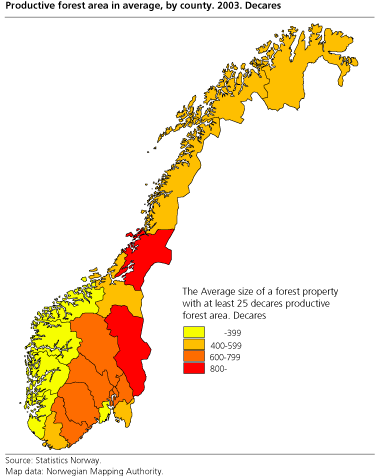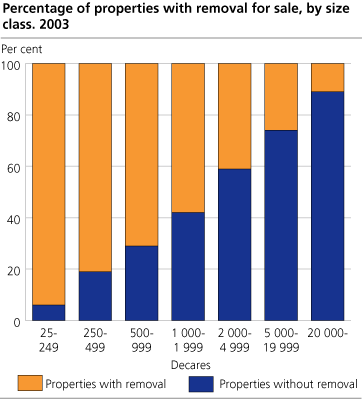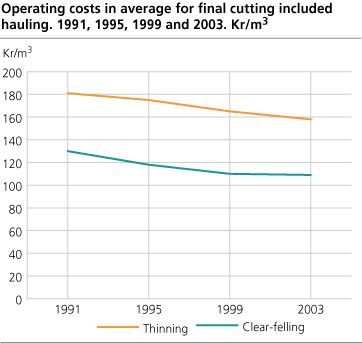Content
Published:
This is an archived release.
Three quarters of forest area profitable
According to the forest owners, three quarters of the productive forest area was profitable in 2003. With 90 per cent profitable forest area, the counties of Hedmark and Akershus have the largest profitable forest areas in Norway. In the western and northern parts of Norway only half of the productive forest area was considered profitable.
According to the forest owners, 78 per cent of the forest area was profitable in 2003. Compared with owners of large forest areas, the forest owners with small properties considered a smaller part of their productive forestland as profitable. Forest owners with at least 5 000 decares of productive forest area, said that 85 per cent of the productive forest area was profitable. Among forest owners with less than 100 decares productive forestland, the corresponding figure was 62.
Small forest properties
Preliminary figures from the Sample Survey of Forestry 2004 shows that there were about 119 000 properties with at least 25 decares of productive forestland in Norway. Three quarters of the properties are less than 500 decares. The average size of a forest property is 575 decares. The total productive forest area has been estimated to be 68.2 million decares.
One in seven forest owners cut for sale
Commercial logging was carried out on 14 per cent of the properties in 2003, a decrease from 21 per cent in 1999. In 2003, a total of 7.9 million m3 were cut, of which 6.9 million m3 round wood were cut for sale. The average cut for sale was 372 m3 per property with removal for sale. In 1999, the corresponding figure was 302 m3.
88 per cent of the total cut for sale came from final cutting, 9 per cent from thinning and 2 per cent from logging of windfall, seed trees and shelter trees.
Contractors did more of the logging
In 2003, 85 per cent of the total quantity for sale was logged by logging machines. In 1999, 67 per cent was harvested by logging machines. In Hedmark, 93 per cent of all roundwood for sale was cut by logging machines, while the corresponding figure in Møre og Romsdal was 23 per cent.
At the national level forest owners and unpaid family members logged 9 per cent of the total in 2003, compared with 16 per cent in 1999. In 2003, contractors accounted for 88 per cent. The remaining 3 per cent was cut by paid hired labour.
Contractors carried out 87 per cent of the hauling, while forest owners and unpaid family members accounted for 11 per cent, and paid hired labour for 3 per cent. In Møre og Romsdal and Sogn og Fjordane the forest owners hauled half of the hauling themselves, while they in Hedmark carried out only 4 per cent.
Lower operating costs
In 2003, the contractors were paid an average of NOK 109 per m3 for final cutting including hauling and NOK 158 per m3 for thinning. The operating costs were somewhat higher in 1999, when the corresponding prices were NOK 110 and NOK 175 per m3 respectively.
There are also county variations. Final cutting including hauling performed by contractors was cheapest in Hedmark, where the cost was NOK 93 per m3, while it was most expensive in Nordland with NOK 164 per m3. The operating costs for thinning were NOK 147 per m3 in Hedmark and NOK 191 per m3 in Oppland.
Management plans less common
The proportion of forest owners with a forestry management plan not older than 15 years has decreased since 1999. Before that the percentage had risen for 20 years. In 2003, 29 per cent of the forest owners had a management plan, while the corresponding figure in 1999 was 33.
The management plans cover 56 per cent of the productive forest area, while the corresponding figure in 1999 was 65 per cent. The properties covered by a management plan had an assessed annual increment of 9.9 million m3. The assessed growing stock for these properties was 283 million m3.
The largest forest areas are more likely to have a management plan than smaller areas. Three quarters of the forest owners with at least 5 000 decares productive forest area had a management plan.
Clear-felling accounts for 60 per cent
In 2003, 61 per cent of the area cleared for regeneration was completely cleared, 18 per cent of the area was cleared by the seed tree method, 4 per cent was area with shelterwood, 7 per cent was cleared plots smaller than 5 decares and the remaining was extensive cleared areas. In 1995, 70 per cent of the cleared area was completely cleared. Four years later the corresponding figure was 66 per cent.
At national level, the average clear-felling area was 19.5 decares, while it was 31 decares in Hedmark. The larger the property, the larger the average clear-felling area. On properties with at least 20 000 decares of productive forest area, the average clear-felling area was 31.5 decares.
Tables:
- Table 1 Profitable area as part of productive forest area, by county and productive forest area. 2003. Per cent
- Table 2 Properties, by size of productive forest area and county. 2003. Decares
- Table 3 Productive forest area, by size of productive forest area and county. 2003
- Table 4 Removals for sale, by type and method of felling. 2003. Per cent
- Table 5 Management plan, by county. 2003
Contact
-
Statistics Norway's Information Centre
E-mail: informasjon@ssb.no
tel.: (+47) 21 09 46 42



